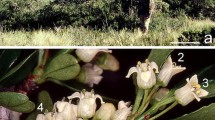Abstract
Mutualists and non-mutualistic cheaters commonly coexist, but the effect of mutualist-cheater interactions on the evolution and stability of mutualisms or persistence of cheater populations is not well understood. Yuccas and yucca moths are an example of an obligate mutualism in which cheaters are frequently present. Larvae of both pollinators and cheaters eat developing yucca seeds, but cheaters no longer pollinate and rely on the mutualist species for seed availability. In this study we focus on interactions between the cheater Tegeticula intermedia and the pollinator T. yuccasella in fruits of the host Yucca filamentosa. We examined the effect of pollinator and cheater density on larval mass and larval mortality, the effect of fruit mass on larval interactions, and the degree of variability in pollinator-cheater interactions across 3 years. This study was done in a natural population to determine whether these two larval species affect each other under natural conditions. Genetic markers (both protein electrophoresis and DNA sequencing) were used to identify the larvae to species. We found no correlation between larval number and mortality for either pollinators or cheaters. Furthermore, pollinator mass was not correlated with number of cheater larvae per fruit in any year. Mass of cheater larvae was not correlated with number of pollinator larvae per fruit in two of three years; in one year, there was a negative correlation between number of pollinator larvae on mass of cheater larvae only in small fruits. Our results suggest that larval competition between species is weak and asymmetric; when it occurs, cheater larvae incur the cost. The number of cheaters and pollinators per fruit was negatively correlated in two of three years. The lack of a positive correlation in number of cheater and pollinator larvae per fruit may contribute to lowering the potential for seed competition among larvae. In addition, larval density per fruit differed across years by as much as 30%. However, this degree of difference was apparently not enough to cause seed limitation because no effect of pollinator larvae on either mass or mortality of cheater larvae was detected in years with the highest larval densities per fruit. In contrast to the weak effects of pollinator-cheater interactions, fruit mass accounted for much of the variation in number and mass of both pollinator and cheater larvae within and across years. Larger fruits generally had heavier and higher numbers of larvae compared to smaller fruits. Overall, in this population at least within the time period studied, pollinators and cheaters coexisted with little conflict in fruit. This result is consistent with the hypothesis that the recent rapid radiation of species in the T. yuccasella complex may be explained in part by the ability of multiple pollinator species (some of whom have become cheaters) to use fruits without severe competition.
Similar content being viewed by others
Author information
Authors and Affiliations
Additional information
Electronic Publication
Rights and permissions
About this article
Cite this article
Marr, D.L., Brock, M.T. & Pellmyr, O. Coexistence of mutualists and antagonists: exploring the impact of cheaters on the yucca – yucca moth mutualism. Oecologia 128, 454–463 (2001). https://doi.org/10.1007/s004420100669
Received:
Accepted:
Published:
Issue Date:
DOI: https://doi.org/10.1007/s004420100669




